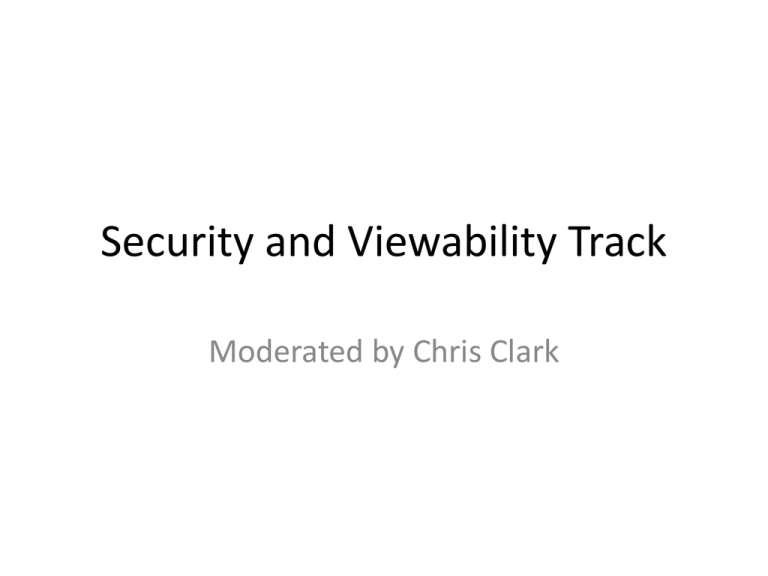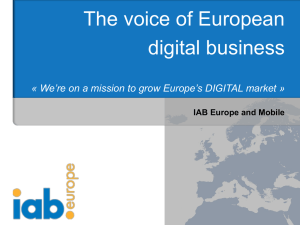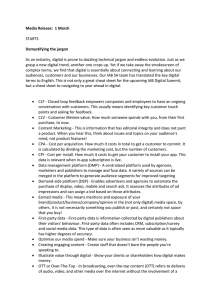group slides
advertisement

Security and Viewability Track Moderated by Chris Clark Agenda • • • • • • • Intro – Ash Kalb (WhiteOps) Device Security – Brad Hill (FB) Human Security – Olivier (Mozilla) Human Security – Brendan Riordan-Butterworth (IAB) Viewability – Mark Torrance – Rocketfuel Viewability – Dan Kaminsky – WhiteOps Discussion Ash Kalb FRAUD Brad Hill FRAUD The advertising ecosystem is a complex and delicate web of balanced trust and distrust that is in danger of unraveling. Users make trust decisions about publishers. The New York Times is a safe site. A Russian warez site is not. Malvertising is catastrophic for this trust model because it collapses the boundaries between good and bad “neighborhoods” online. Enterprise administrators are increasingly regarding ad blocking as an essential on par with anti-virus for this reason. End users are following the trend. Publishers have to trust advertisers and ad networks to give them safe and appropriate content. They don’t really trust them, but few have the market power to demand better security, narrow their circles of trust, or the technical capabilities to ‘trust but verify’. Advertisers and ad networks don’t trust publishers. Fraud is rampant; they want to verify that they’re paying for real humans to see their ad. We need to improve the platform tools that let us balance these concerns. Less trust, more guarantees. If you can’t sandbox it, you must be able to analyze it. If you can’t analyze it, you must be able to sandbox it. Some approaches… Ad “stitching” • Inline ads with publisher content on the server-side. • Simple, fast. • Happens today many places with JS tags. When is stitching OK? • It’s not sandboxed at all, so you have to be able to analyze it completely. • Highly constrained formats only. – Transcoded image or video + text – No script, no Flash, no XHR, no cookies... • Doesn’t play well with independent measurement techniques as they exist today. (black box scripts) iframes and sandboxing • Strong isolation; content can do mostly arbitrary things inside the sandbox without negative impacts on user or publisher. • Enforcing what content is shown and where links go (e.g. no malware sites or porn) is still difficult. • Few have wanted to use it. – “Can you make it work with plugins?” – New opportunity with the end of Flash? Ad network hybrids • Analysis + Sandboxing together • Ad network acts as a single trusted party and hosts all content – Ensures content can’t change after analysis – Analysis of arbitrary content still is only tractable through using iframes, JS shimming, Content-Security-Policy, etc. • No standards yet for this so that, e.g. creative authoring tools can reliably produce secure ads that work on any network – Independent measurement is still a problem, mostly devolves again to trusted whitelists of black-box scripts Where can the W3C and the WebAppSec WG help? • We’re working on Iron Frame • What else is missing in the platform? • What can we do with iframe sandboxing to make it more attractive and useful? Should independent measurement and audit be a first-class citizen in the web platform? • Declarative reporting like Content-SecurityPolicy? • Imperative inspection and limited messaging from an “isolated world”? Brendan Riordan-Butterworth HUMAN SECURITY User Security: Premise • The network is hostile. User security is improved with secure communication channels and by reducing the number of hosts the client talks to. • Therefore, we need to: – Secure communication channels by moving to HTTPS – Reducing the hosts count through Server Side Ad Stitching Advertising Industry Tree Publisher Ad Server Publisher Publisher Data Partners Verification Tools 3rd Party Ad Server 3rd Party Data Partners Additional Ad Servers And Data Partners Resistance to Snooping • Human communicates over HTTP, with many 3rd parties. – Many, easy opportunities for snooping. • Human communicates over HTTPS, with many 3rd parties. – Many, difficult opportunities for snooping. • Human communicates over HTTPS with a single party. – Few, difficult opportunities for snooping. HTTPS: Adoption • The move to HTTPS is underway. • Adoption was slow at the outset, because moving to HTTPS meant access to fewer advertisers and advertising partners. • Now, a primary deterrent is user experience impact due to misconfiguration. HTTPS: What’s Next? • IAB Tech Lab is developing an Ad Tech HTTPS Implementer's Guide – For those companies lagging, – As a checklist for those who want to make sure their implementations are taking into account all things. • Other efforts? Server Side Ad Insertion • How? The web server coordinates the delivery of creative more directly than putting a reference to 3rd party JavaScript on page. – In audio scenarios, the server generally acts as a proxy for the entire creative. – In video scenarios, the server sometimes proxies the entire creative, sometimes uses HLS. – In other scenarios, it's still being figured out. Server Side Ad Insertion: Benefits • Fewer connections. • More advertising scenarios enabled – podcasts – generic players – offline, cached, and multiple plays • Direct scanning of the creative – malware and ad quality vetting. Server Side Ad Insertion: Costs • Scaling trust and addressing fraud – Depending on publishers to be honest is risky. – There are significantly fewer ad networks than web sites. • Decreased creative feature set – Less dynamic, rich creative. • Decreased data accessibility / user value • Increased cost to the server. • Decreased user-facing transparency Server Side Ad Insertion: What’s Next? • Address the trust issue. – Guidelines for measurement – Auditing and validation processes – Others? • Technologies – Server-to-server transfer of advertising assets. – Device or user identification and preference synchronization. IAB and Tech Lab • As a trade organization, the IAB work in developing standards-track is unexpected. • As such, we've split these efforts out to the Tech Lab, which aims to develop: – Specifications and Guidelines for advertising protocols – Source code of reference implementations and tools to speed adoption. – Tools and services to validate implementations Tech Lab • We're standing on the work done by W3C, IEEE, and other organizations to make these things as accessible as possible: – Specs are developed by working groups that operate under an IPR that dictates a strong preference for RF-RAND. Neither the IAB nor IAB's Tech Lab have yet operated a working group under RAND. – Source code is licensed under BSD 2-Clause. Mark Torrance VIEWABILITY Dan Kaminsky VIEWABILITY




